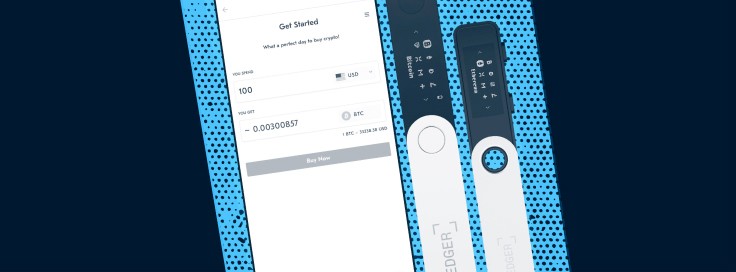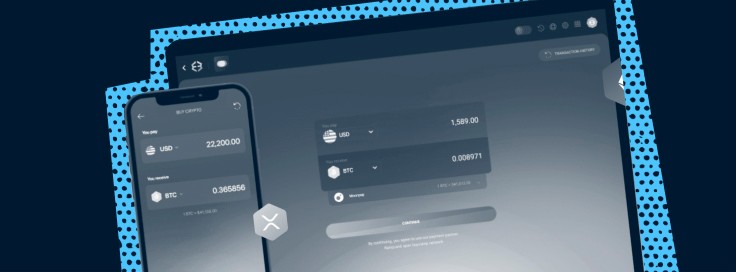Staking with crypto wallets involves “freezing” coins without redirecting them to third-party services. This type of passive income from crypto-assets is gaining popularity, so cryptocurrency wallet developers are adding staking to their services.
Here’s how to choose a staking wallet and which of them are the most popular.
How to Choose a Staking Wallet
When choosing a cryptocurrency wallet for staking, you need to consider several factors fundamental to generating income:
- Convenience. Using a wallet should not cause difficulties and its functionality should be easy to understand.
- Type of wallet. There are different wallets for storing cryptocurrencies: hardware, desktop, mobile, etc. Storage and staking on them are implemented differently, so the investor should make sure they choose the right one.
- Availability of coins for staking. In order to send certain tokens to staking, the chosen wallet must support them. Not all cryptocurrencies are available on all wallets.
- Staking rewards. Staking reward amounts may vary depending on the wallet you choose.
- Fees. Different services provide access to staking, charging different amounts of fees. Therefore, the investor should understand the terms of use of wallets and choose an acceptable option.
So, having picked the right wallet for staking, you can start freezing tokens and make passive profits.
Best Wallets for Staking
Here are several of the most popular wallets that support staking crypto-assets. Let’s take a look at what coins can be sent to staking, for how long and under what conditions, and most importantly, what kind of profits can be made.
Trust Wallet

Trust Wallet, a multi-currency mobile wallet, allows you to receive passive income from staking various crypto-assets. There are 12 coins available for staking:
- Binance Coin (BNB)
- TRON (TRX)
- IoTeX (IOTX)
- Tezos (XTZ)
- Kava (KAVA)
- Algorand (ALGO)
- Terra (LUNA)
- VeChain (VET)
- Callisto (CLO)
- Osmosis (OSMO)
- TomoChain (TOMO)
- Cosmos (ATOM)
One of the advantages of staking on Trust Wallet is that there are no fees. To start staking, you need to select a coin supporting this function and “freeze” a certain amount by selecting the Stake option in the drop-down menu. The process can be monitored through the Stake Details option, and Claim Rewards will allow you to calculate the interest rate for the selected staking period: day, month, or year.
The investor can withdraw coins from staking at any time using the Unstake tool. If coins are withdrawn early, the investor must pay a validator fee. The assets will be available in 5-21 days — depending on the selected cryptocurrency. However, it should be taken into account that the yield on an early withdrawal will be significantly lower than expected.
Trust Wallet provides the highest interest rates for staking Osmosis (OSMO) — 84% per annum. For staking popular coins like BNB and KAVA, the service offers remuneration of 10% and 11% per annum, respectively. The wallet offers the lowest interest rates for staking TRX and LUNA — about 4%.
Atomic Wallet

A decentralized cryptocurrency wallet that allows you to generate passive income through staking. To do this, you need to delegate coins to addresses provided by the wallet.
The wallet doesn’t charge internal fees for staking, but the investor will have to pay a validator fee. The amount of commission depends on the coin and the chosen validator. The Atomic service offers verified validators for staking with the commission amount clearly shown in the network. Fees are charged when assets are transferred to the validator and every time the investor requests fee withdrawals.
Gas payments are often made in native tokens of the blockchain network in which the staking is implemented, or “frozen” tokens in the absence of utility coins. Therefore, the investor should pay attention to the balance of coins in the account or the availability of special tokens to pay for gas in the wallet.
The most popular tokens for staking on Atomic Wallet include:
- Atomic Wallet Token (AWC). Only BEP-2 standard AWC staking on Binance is supported, the expected annual interest rate is 20%, and the minimum staking period is seven days. The minimum amount for staking is 10 AWC.
- Band Protocol (BAND). Only the BAND mainnet tokens are supported for staking, the annual interest rate is 11%, the minimum staking period is 21 days, and reward payments are made daily. The minimum amount for staking is 1 BAND.
- Zilliqa (ZIL). The minimum amount for staking is 10 ZIL, and the minimum period is two days. The reward is generated with each new block, which is approximately 24-36 hours. The expected annual return is 14%.
- Tezos (XTZ). The expected return is 7% per annum, and the minimum rate for staking is 1 XTZ. Remuneration will be paid after 22 cycles, i.e., after about two months. Further payments will be available every seven cycles, or every 20 days.
- Solana (SOL). The minimum amount of coins for staking is 1 SOL, the expected profit is about 7% per year. The first reward will be available in six days, with further ones available every three days.
Atomic Wallet offers Icon (ICX) and Cosmos (ATOM) staking with an expected annual profit of 10%, as well as Cordano (ADA) and Tron (TRX) cryptocurrencies with a possible return of 5% per year.
Ledger

Ledger, a cold hardware wallet, is one of the safest ways to store cryptocurrencies. All assets are on a physical device disconnected from the Internet, which greatly increases their level of protection against hacking.
Staking through the Ledger hardware wallet is available in two ways:
- By using Ledger Live, a crypto staking app for the wallet. The investor needs to install the extension on their wallet and create an account. The list of available coins for staking is limited.
- Through third-party wallet applications. This method involves installing a third-party app on the hardware wallet to store and manage the coin selected for staking. The investor must then delegate funds to it.
The second method is not secure because coins are delegated to third-party services, but it expands the list of possible coins for staking with Ledger hardware wallets.
The following tokens are available for staking with Ledger Live:
- Polkadot (DOT). The profitability of the asset is 10% per year. Choosing the validator for DOT staking plays the most important role in profit-making, as only a certain number of validators can qualify for the reward, which is accrued every 24 hours. It takes 28 days to withdraw the asset from staking.
- Tezos (XTZ). The expected annual return is about 6%. The first profit from staking XTZ can be obtained after five weeks, further rewards will be accrued every three days.
- Cosmos (ATOM). The current annual return of Cosmos is 8-10%. Rewards for ATOM staking depend on the popularity of the chosen validator (only the top 125 validators can distribute rewards) and are accrued from day one. It takes 21 days to remove an asset from staking or to change validators.
- Algorand (ALGO). The minimum amount for staking in the Algorand network is 1 ALGO, and the expected return is 5-6% per year. Rewards are earned each time a transaction occurs in the account, so investors often make 0 ALGO transfers to receive staking rewards.
- Tron (TRX). The expected annual return is 7%. TRX staking rewards will accrue every 24 hours and will depend on the Super Representatives (SR) selected.
Exodus

Exodus, another cryptocurrency wallet, doesn’t require downloading the entire blockchain to perform staking. The wallet app can be installed on desktop devices, or you can use the mobile version for iOS or Android.
Exodus offers staking of seven cryptocurrencies:
- Solana (SOL). The expected annual percentage yield is in the range of 6%. Coins can be deposited from 1 month to two years. SOL staking is done through Everstake validators. Coins take 2-4 days to be unlocked.
- Cardano (ADA). The expected annual return on the asset is 5%, but ADA yields can vary depending on the number of coin holders. The minimum stake is 5 ADA.
- Cosmos (ATOM). The annual staking yield is 16%. ATOM sent for staking can be unlocked after 21 days, even in the case of early withdrawal.
- VeChain (VET). Rewards for staking VET are credited in VTHO coins, the equivalent of 1 VET = 0.000432 VTHO. Rewards are paid automatically every ten seconds. The expected profitability of VET is 1.09% per year.
- Ontology (ONT). The annual return on staking ONT is 19%. Rewards and payments are made in Ontology gas (ONG) native tokens. Staking rewards are accrued every second, and the investor will need to pay 0.01 ONG for each withdrawal.
- Algorand (ALGO). The ALGO staking yield is 10% per annum. The maximum staking period is 24 months. Remuneration is accrued based on the number of transactions in the Algorand network.
- Tezos (XTZ). The annual return is 5.66%. Rewards for XTZ staking will be accrued approximately every 20 days.
Staking on the Exodus multi-currency wallet doesn’t require any special technical knowledge from the investor and is simple, as well as the entire interface of the wallet. To set up your passive income, you need to select a coin and send it for staking using the Stake button. To check the reward balance, you need to go to the Earn Rewards section and click on Claim Rewards.
CoinsPaid Wallet

CoinsPaid, a multi-currency crypto wallet, focuses on B2C and B2B clients. The main features of the wallet are:
- Sending and receiving crypto payments with zero fees between user accounts.
- Support for over 30 cryptocurrencies and over 20 fiat currencies.
- Low fees for recurring payments.
- Online access to several popular cryptocurrency exchanges.
- Built-in exchange for buying and selling cryptocurrencies via debit cards.
CoinsPaid was awarded the Excellency in Digital Wallet at the Finnovex Qatar 2022 event in March for its wallet development.
CoinsPaid’s CPD token is the first multi-chain DeFi token designed for online merchants and runs on Ethereum, Polygon and BNB Chain blockchains. CPD staking is available as part of the CoinsPaid loyalty program for B2B customers.
The minimum CPD staking period is 30 days. As a reward, the company offers discounts on commissions for B2B customers. The size of the discounts depends on the number of CPD sent for staking. The maximum possible discount for participation in staking is 20% for transactions in any cryptocurrencies, and 40% for transactions in CPD.
Therefore, both “cold” and “hot” cryptocurrency wallets can be used for staking. Staking can generate direct and indirect income through discounts, loyalty programs, and other bonuses. The choice of a staking wallet depends on the cryptocurrencies to be “frozen” and the specifics of the chosen staking type.










